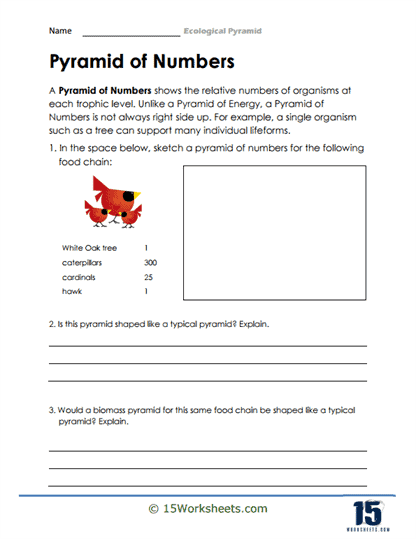Organisms and Trophic Levels

Worksheet Description
You are given a defined food chain and asked to sketch a pyramid of numbers. This worksheet revolves around the concept illustrating the relative count of organisms at different trophic levels within an ecosystem. Unlike its counterpart, the Pyramid of Energy, the Pyramid of Numbers can sometimes be inverted, as certain primary producers like trees might only be represented by a single individual that supports numerous other organisms. Here, students are provided with a specific food chain involving a White Oak tree, caterpillars, cardinals, and a hawk. They are instructed to sketch a pyramid based on the numerical data given, and subsequently analyze its shape and contrast it with a potential biomass pyramid for the same chain.
To approach this worksheet, students should first examine the provided data, noting the number of organisms at each trophic level. Using this data as a foundation, they should then visualize and draw the pyramid, ensuring each trophic level is represented proportionally according to the number of organisms. Once the pyramid is sketched, students should engage in analytical thinking, determining whether the shape of their pyramid aligns with a conventional pyramid shape. Lastly, they are encouraged to theorize how a biomass pyramid for this food chain might appear, and provide reasoning for its potential structure.
The primary objective of this worksheet is to enhance students’ comprehension of ecological pyramids and the intricacies of trophic interactions within ecosystems. While the Pyramid of Energy typically displays a decreasing trend from the base to the apex, the Pyramid of Numbers can vary based on the nature of the primary producer and the organisms it supports. By constructing and analyzing their own pyramid, students hone their visualization and critical thinking skills. The worksheet ultimately underscores the importance of understanding the complex interrelationships among organisms and the factors that shape ecological structures.
